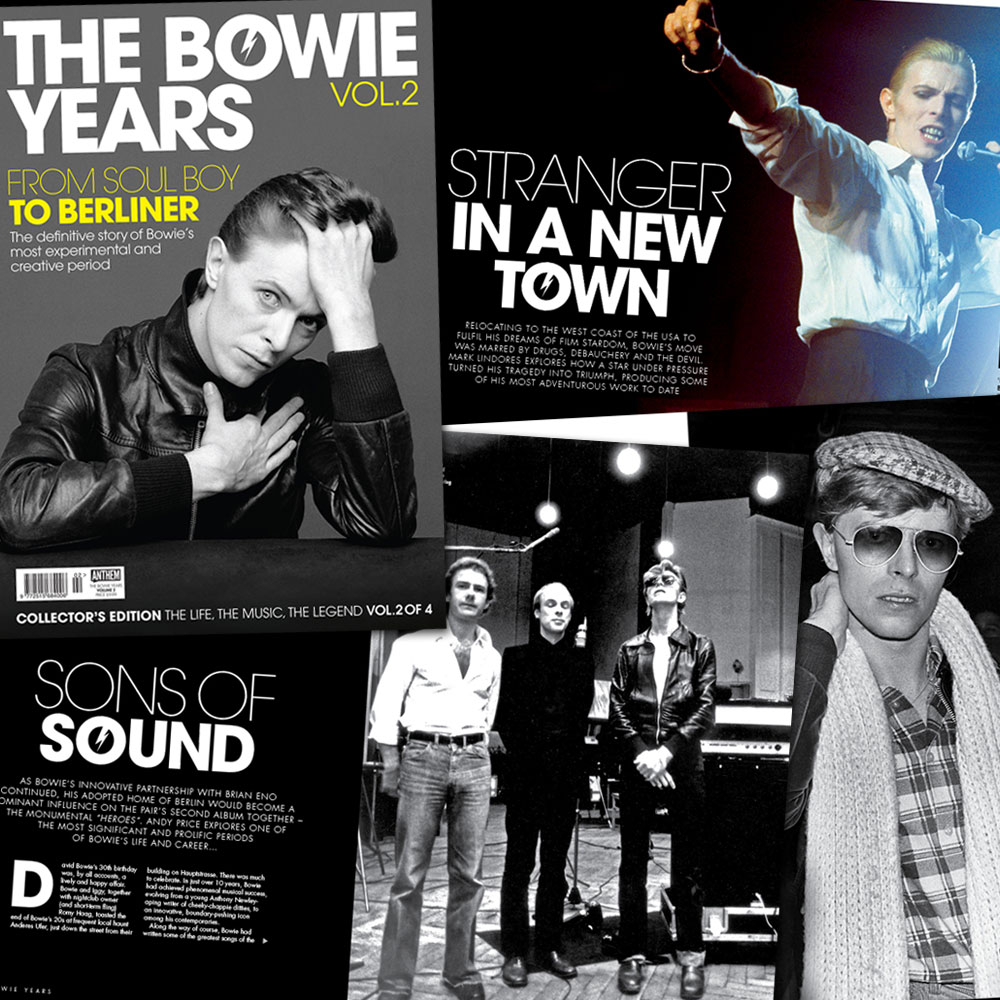“Never no turning back”
Editor at Large (Andy Price) has been in touch with details of the second instalment of four, of the superb The Bowie Years (TBY).
This volume covers 1975 - 1980 and includes track-by-track analysis of the Bowie songs from the period, along with in-depth biographical features, a piece on the influence this period Bowie has had, an Alternative Top 20 and a brand new interview with both Carlos Alomar and Robin Clark.
The Bowie Years Volume 2 is available on Thursday 19th April, pre-order here.
There’s also a 25% saving in the offing if you’re interested in the complete Bowie Years collection, which, to our reckoning (having done the math), is one instalment for free!
We’ll leave you with the top ten of TBY Alternative Top 20 - 1975-1980. Perhaps you could suggest your own alternative Top 20 from the latter half of the 70s in the comments section. The only criteria is no singles...not such an easy task!
+ - + - + - + - + - + - + - + - + - + - + - + - + - + - +
10: Repetition (1979)
09: Word On A Wing (1976)
08: Right (1975)
07: Breaking Glass (1977)
06: Win (1975)
05: Sense Of Doubt/Moss Garden/Neuköln (1977)
Though three distinct tracks with quite different feels and textures, these expressive instrumentals (when listened to as they’re supposed to be listened to - in consecutive order) represent the aural equivalent of a train ride through the shell of a multi-cultural city, with the doomy, oppressive Sense of Doubt leading serenely into the relative tranquillity of the oriental Moss Garden, before culminating with one of Bowie’s most expressive musical performances on the isolated and mournful Neuköln - Bowie’s sax takes over the lead vocal role and becomes a wailing, anguished banshee in perhaps the finest sequence of instrumentals that Eno and Bowie conceived. Though Low’s second side was more colourful, Heroes’ instrumental half works arguably more effectively as one shifting suite of moods. Aside from the nuanced, rich mix it’s also profoundly moving emotionally. Genius.
04: It’s No Game (No 1) (1980)
Scary Monsters’ punchy, uncompromising opener is notable for a number of reasons - the alarmed delivery of the Japanese lyrical elements by Michi Hirota, Bowie’s screamed, howling vocals and the baffling hysteria of Robert Fripp’s sequence of guitar riffs demand attention from the listener. If Scary Monsters was Bowie reclaiming the contemporary pop landscape of 1980, then It’s No Game (No 1) is the opening salvo - a challenge to both the theatrical snarling of the punk movement and the right-on sanctimoniousness of the protest song. The song also frets about mortality, and in particular that fame might lead to assassination, with Bowie’s lyric ‘put a bullet in my brain, and it makes all the papers’ The song’s twin (It’s No Game No 2) closes the record and is a gentler, more restrained version of the same song. One of the album’s key tracks. It’s No Game (No 1) launches Scary Monsters with gripping, effective power.
03: Always Crashing In The Same Car (1977)
Allegedly inspired by Bowie’s unfortunate incident in an underground parking-lot in Berlin where he, in a state of inebriation, wrote off his 1950’s Mercedes, Always Crashing In The Same Car is one of Low’s standout tracks. The song also works as not just a real-life memory put to music, but as a work of self-reflection, where Bowie ‘going round and round the hotel garage’ serves as an apt metaphor for his then uncertain and highly depressed state of mind. It features some outstanding guitar work from Ricky Gardiner with a solo that takes centre stage in the mix (though the melody of the solo was originally whistled to Gardiner by Bowie). The rest of the mix is full of sumptuous elements, including Eno’s shimmering synth under-bed. Bowie would perform the track live for the first time twenty years later on the Earthling tour
02: Teenage Wildlife (1980)
By 1979, Bowie’s heir apparents were on the rise, emerging from the Bowie nights being held in clubs such as Billy’s and the Blitz, the next generation of the pop aristocracy were consciously cribbing from Bowie’s visual and musical lexicon and re-shaping it in their own image. Teenage Wildlife is Bowie’s own response to those taking their cues from his body of work, the nature of the cyclic industry and an embittered warning to those in pursuit of fame for its own sake. Though the lyrics contain harrowing, distressing imagery the wonderfully exaggerated vocal delivery, triumphant melody and Fripp’s searing guitar riff make the track one of Scary Monsters highlights.
01: Station To Station (1976)
The longest studio track in the Bowie canon is also one of his most outstanding. Unveiling the shadowy Thin White Duke character - a slick, monochromatically dressed European aristocrat who Bowie described as a ‘would be romantic with absolutely no emotion at all’. Opening with a synthetic train sound before a portentous two-note, repetitive piano motif heralds the Duke’s arrival. The eerie squall of Earl Slick’s guitars counterpoints the imposing, ominous march of Bowie’s tight-knit rhythm section, before the track slows down for a beautifully serene chorus. Melodically and sonically the song is intensely rich, however it’s in both Bowie’s towering vocal performance and the lyrical content of the song where we find, yet again, the track’s real meat - a poetic, and somewhat introspective song that longs for resolution. Once again Bowie evokes the occult, with references to Aleistair Crowley, as well as the Kabbalah, not to mention the overt lyrical references to cocaine - a drug that Bowie was growing ever-dependent on during this period and a key ingredient in the cauldron that yielded the Duke. Station To Station is a true Bowie epic and a harbinger of his upcoming European based, experimental works. One of his finest, and most unique, songs.
#TheBowieYears

